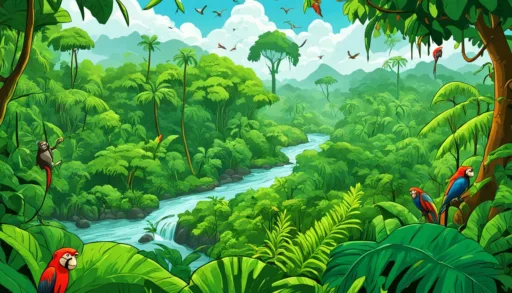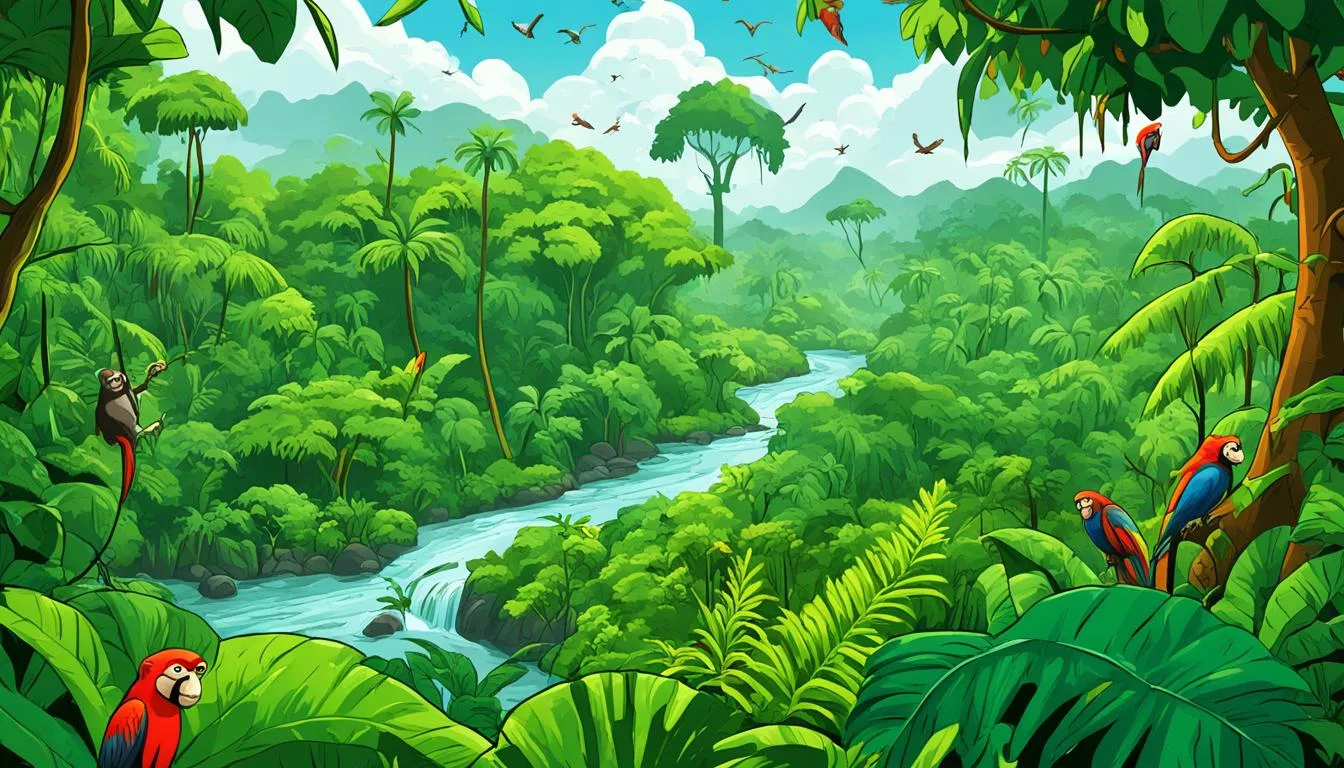Often overlooked on travel bucket lists, Equatorial Guinea’s unique charm and climatic sweet spots remain one of Central Africa’s best-kept secrets. Yet, when considering a **tropical adventure**, seasoned travelers and novices alike might ponder, “What is the best time to visit Equatorial Guinea?” As you dive into Equatorial Guinea vacation planning, understanding the nation’s heartbeat through its travel seasons is key to a memorable expedition. Nestled in a perfect equatorial harmony, this hidden gem offers a vibrant mix of cultural experiences and natural escapades waiting to be discovered at the **optimal travel times**.
Whether looking to savor the rich Spanish-infused history or the lush biodiversity that frames the islands and the mainland, **Equatorial Guinea travel recommendations** suggest a surprising timeline for your journey. The dry seasons of June to August and December to February are your best bets for crystal-clear skies and uninterrupted exploration. Beyond these periods, the notion of an ideal getaway might just be redefined amidst the country’s warm yearlong embrace.
Key Takeaways
- Discovering the best travel times for Equatorial Guinea can drastically enhance your vacation experience.
- Avoiding common misconceptions about tropical travel is crucial in planning your Equatorial Guinea adventure.
- The dry seasons offer an opportunity for tourists to enjoy the richness of the local architecture and natural landscapes.
- Peak times for wildlife sightings and cultural festivities occur during Equatorial Guinea’s dry weather periods.
- Adapt your travel expectations as Equatorial Guinea’s climate might offer pleasant surprises outside of traditional travel seasons.
Understanding Equatorial Guinea’s Tropical Climate
Delving into Equatorial Guinea’s climate means exploring a world where the lush intensity of the tropical rain-forest climate meets the expanses of the tropical savannah. Before you venture into this equatorial haven, familiarizing yourself with the regional weather variations and the sultry patterns that define mainland and island life is key to a harmonious journey.
The Tropical Rainforest and Savannah Climate of Equatorial Guinea
An enchanting mix of dense rainforest canopies and wider savannah landscapes awaits travellers to Equatorial Guinea. The country’s position, cradled by the warm currents of the Atlantic, gifts it with a tapestry of weather conditions, where high humidity and generous precipitation foster an evergreen environment that’s a hub for biodiversity. Seeking Equatorial Guinea climate advice often leads to the discovery that Monte Mitra, with its imposing elevation, exerts a cooling influence, offering a refreshing contrast to the coastal warmth.
Regional Weather Variations: Mainland vs. Islands
The climate narrative further diversifies when contrasting the mainland Rio Muni to the volcanic island chain, including the vibrant Bioko, where the capital, Malabo, thrives. Each area dispenses its unique meteorological profile – the mainland’s heart resonates with the rhythm of the Equatorial sun punctuated by seasonal rains, while the islands are caressed by milder maritime breezes, shaping a less predictable, albeit equally captivating weather panorama.
Year-Round High Temperatures and Humidity
No matter where you find yourself within Equatorial Guinea’s varied domain, a common thread weaves through the climate: the marriage of relentless temperatures and the clasp of high humidity. With mercury levels that seldom dip below 86°F during the day and seldom rise above 62°F at night, packing for this ever-warm milieu necessitates a wardrobe that can breathe with the tropical tempo. As travel plans crystalize, considering incessant warmth and moistness is vital in ensuring comfort and health remain paramount companions on your equatorial escapade.
Best Time to Visit Equatorial Guinea
Pinpointing the ideal Equatorial Guinea travel seasons is essential for those seeking a seamless adventure in this tropical paradise. Appreciate its untamed beauty, from balmy beaches to emerald rainforests, during the most favorable best travel times. Firstly, consider the dry season, spanning from December to February, blessed with azure skies and scarce rainfall, laying out perfect backdrops for uninterrupted explorations.

Dive into a thrilling itinerary that harnesses the serenity of this season. This period allows for full-blown enjoyment of the country’s luscious flora, vivacious fauna, and majestic architectural marvels. Don’t let the unexpected downpour put a damper on your journey; the dry season ensures your plans remain as clear as the sunny skies above.
Yet, even in this idyllic time, certain travel nuances must be acknowledged. With the omnipresent tropical essence come the near-constant high temps and humidity. Thus, packing lightweight, breathable attire is paramount, coupled with effective insect repellent to thwart the buzz of persistent mosquitoes.
For those venturing during the more challenging wet season, typically from April through October, expect the heavens to open up. Copious rainfall can test even the most well-arranged travel routes, potentially reshaping your adventure. Being prepared for this season’s swings—from torrential downpours to stifling humidity—is more than just sensible; it’s crucial.
Forearmed with this Equatorial Guinea weather guide, travelers can craft experiences that resonate with the country’s rhythm, ensuring that each tropical minute is as enriching as envisioned.
Exploring the Cultural Richness of Equatorial Guinea During Ideal Seasons
Traveling to Equatorial Guinea offers an exceptional opportunity for cultural exploration, particularly during the dry seasons when the climate is most inviting. From the Spanish colonial architecture to the festive celebrations, visitors can immerse themselves in the vibrant culture and warm hospitality that characterize this unique Central African nation.
Discovering Spanish Colonial Architecture
Equatorial Guinea tourist tips often highlight Malabo, the nation’s capital, as a treasure trove of Spanish colonial architecture. The picturesque city streets are lined with historical buildings that offer a window into the colonial past of the country. Structures such as the Cathedral of Santa Isabel stand as majestic landmarks, blending European design with tropical elements, creating a fusion representative of Equatorial Guinea’s diverse heritage.
Celebrating Local Festivals in Optimal Weather
Participating in local festivals is a must-do for anyone eager to delve into the cultural heart of Equatorial Guinea. The optimal dry seasons align perfectly with notable celebrations such as Africa Day and Independence Day. During these times, the streets come alive with parades, music, and dance, allowing tourists to join in the reverie and experience authentic local traditions firsthand.
| Festival | Date | Activities |
|---|---|---|
| Labor Day | May 1 | Parades, Speeches |
| Africa Day | May 25 | Cultural Exhibitions, Performances |
| Independence Day | October 12 | National Celebrations, Firework Displays |
In conclusion, Equatorial Guinea’s rich history and festive spirit provide ample opportunities for travelers seeking both architectural wonders and vibrant cultural experiences. By planning a visit during the dry and sunny seasons, one ensures the perfect backdrop for a journey rich in discovery and participation in the country’s lively traditions.
Navigating Equatorial Guinea’s Peak, Shoulder, and Off-Peak Seasons
For the astute Equatorial Guinea trip planner, an essential aspect of journeying to this tropical haven is understanding the varying seasons. Each season, whether peak, shoulder, or off-peak, dramatically influences not just the experiences on offer but also logistics such as accommodation and transportation.
Travel Tips for the Dry and Wet Seasons
The peak season typically coincides with the dry months, boasting excellent weather conditions for savoring Equatorial Guinea’s sandy beaches and diverse wildlife. During these months, travelers are advised to book accommodations well in advance and to remain prepared for higher expenses and larger crowds. Conversely, the shoulder season sees occasional showers that refresh the lush landscapes, creating ideal conditions for those who delight in the natural bloom of flora and less crowded tourist spots.
When planning a trip, it’s also crucial to consider the off-peak season, which may deter some with its heavy rainfalls, but also offers a unique spectacle of the region’s abundant waterfalls and rivers at their fullest. Nonetheless, accessibility to certain regions may become limited, urging travelers to ensure that their itinerary remains flexible.

Pros and Cons of Visiting During Different Times of the Year
Each season in Equatorial Guinea presents its own set of advantages and challenges. To help travelers navigate these times, the following list outlines some general travel tips tailored to the conditions you may encounter:
- Peak Season:
Take advantage of the weather for outdoor activities but be prepared for premium pricing. - Shoulder Season:
Enjoy fewer crowds and milder weather, perfect for those in search of tranquility. - Off-Peak Season:
Suitable for budget travelers who don’t mind unpredictable weather and are looking for deals on accommodation.
Before embarking on your tropical escapade, remember to assess health advisories and obtain necessary vaccinations. Travel insurance is not just a recommendation but a vital part of your travel preparations, providing coverage for unexpected events, regardless of the season you choose to visit Equatorial Guinea.
Adventure Opportunities in Equatorial Guinea’s Natural Wonders
Equatorial Guinea’s lush rainforests and pristine beaches offer some of the most spectacular and untouched natural wonders on the African continent. This biodiversity hotspot is a treasure trove for both eco-tourists and adventure seekers looking to immerse themselves in unique flora and fauna.

Wildlife in Monte Alen National Park
Embark on an adventure into the dense forests of Monte Alen National Park, a haven for wildlife enthusiasts. This park is brimming with exotic species that roam freely in this expansive protected area, offering once-in-a-lifetime sights for visitors.
| Animal Species | Best Viewing Times | Adventure Activities |
|---|---|---|
| Gorillas | Early Morning | Guided Nature Walks |
| Chimpanzees | Late Afternoon | Jungle Trekking |
| Forest Elephants | Mid-Day | Photo Safaris |
Relaxing on Arena Blanca Beach: Best Times to See Butterflies
For those seeking a serener encounter with nature, the white sands of Arena Blanca beach become a canvas for one of nature’s most delightful displays. The dry season sparks the migration of thousands of butterflies, coloring the beachfront with a mosaic of fluttering wings.
- Witness the spectacular butterfly migration during the dry season
- Enjoy peaceful beach picnics while surrounded by natural beauty
- Engage in water sports amid a scenic backdrop
Whether it’s the pursuit of thrilling adventure activities in the heart of the jungle or the leisurely exploration of serene coastal paradises, Equatorial Guinea’s natural wonders are a magnet for those looking to forge unforgettable memories in some of the world’s most secluded natural environments.
Health and Safety: Planning for a Risk-Free Tropical Journey
When considering a trip to Equatorial Guinea, prioritizing your health and safety is instrumental in ensuring a pleasant experience in this beautiful tropical destination. Adequate preparation can help protect against health risks and provide peace of mind as you explore the country’s wonders.
Vaccinations and Health Precautions for Travelers
Before embarking on your Equatorial Guinea adventure, reviewing travel health notices and scheduling a visit to your healthcare provider is crucial. By doing so, you can receive essential vaccinations such as those for yellow fever—a must-have since the disease is present. Additionally, prophylaxis for malaria and vaccinations for dengue and Zika virus are also recommended.
Beyond vaccinations, taking health precautions is key. Here are practical tips to safeguard your health:
- Use insect repellent to prevent mosquito-borne diseases.
- Wear long-sleeved shirts and trousers, especially during the dawn and dusk hours.
- Ensure you have access to clean drinking water and practice good food hygiene to avoid gastrointestinal issues.
By following these guidelines, you can minimize health risks and focus on enjoying the vibrant culture and biodiverse environment of Equatorial Guinea.
Staying Safe While Enjoying Equatorial Guinea’s Splendors
To embrace the splendors of Equatorial Guinea with confidence, safety advice is just as important as health preparations. Tourists should exercise vigilance, especially in less populated or isolated areas, and always keep a close watch on personal belongings. Valuables should be secured, ideally in a hotel safe, when not needed on excursions.
Since cash transactions are predominant, it’s advisable to carry limited amounts and be discreet when handling money. Brushing up on your Spanish can significantly enhance your ability to navigate through transactions and interactions smoothly. Additionally, respect for local customs and culture goes a long way in fostering positive relations with the community.
By combining practical safety with the recommended health strategies and Equatorial Guinea health and safety protocols, your visit will be not only memorable but also worry-free.

Conclusion
Embarking on a journey to the heart of Central Africa’s Equatorial Guinea introduces travelers to a vivid tapestry of experiences, from the lush depths of its rainforests to the rich historical fabric of its Spanish colonial past. To fully maximize your travel experience, careful consideration of the Equatorial Guinea travel seasons is paramount. Selecting the optimal travel time, generally the dry seasons, can significantly enhance your engagement with the country’s breathtaking landscapes and cultural festivities. Dry season periods allow for unrivaled wildlife encounters, stress-free navigation, and outdoor events to unfold under the warmth of a tropical sun.
Maximize Your Experience with the Right Travel Timing
With these ideal timeframes in mind, orchestrating your vacation to coincide with these seasons ensures you get the most out of each day. Whether wandering the well-preserved Spanish colonial streets or waiting for the momentous flutter of butterflies at Arena Blanca Beach, timing becomes a crucial companion in curating a journey rich with authenticity and discovery.
Leave Room for Spontaneity Despite Seasonal Planning
However, it is the element of spontaneous travel that embroiders the unexpected and serendipitous threads into the fabric of your adventure. By maintaining flexibility within your itineraries, space is made for the unpredictable joys and unique rhythms that Equatorial Guinea sporadically unveils, regardless of season. So while ideal planning anchors your expectations, let spontaneity guide you to the soul of this Equatorial haven for a trip that truly resonates with the pulse of Africa’s intriguing tropical enclave.






